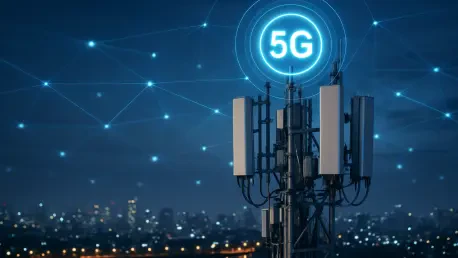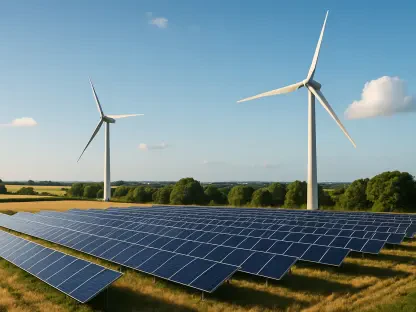In a world where connectivity defines progress, the seamless integration of 5G technology with the Internet of Things (IoT) has emerged as a game-changer by mid-2025, reshaping how industries operate and how people live. This powerful synergy is no longer a distant dream but a tangible force driving unparalleled speed, efficiency, and automation across various sectors. From smart homes that anticipate needs to healthcare systems that save lives with real-time data, 5G’s ultra-fast speeds and minimal latency are unlocking the full potential of IoT devices. The impact is evident in bustling cities managing traffic with precision and in factories predicting equipment failures before they happen. This technological leap is not just about faster internet; it’s about creating a smarter, more responsive world. Delving into this transformation reveals how 5G is fueling innovation, boosting economies, and addressing modern challenges with cutting-edge solutions.
The Technological Backbone of 5G and IoT
Core Advantages Fueling Innovation
The foundation of 5G technology lies in its remarkable ability to deliver lightning-fast data speeds, drastically reduced latency, and the capacity to connect a vast number of devices simultaneously, forming the bedrock of IoT’s rapid evolution. These core strengths enable real-time data processing that was once unimaginable, allowing for seamless communication between devices in diverse environments. In urban planning, for instance, traffic systems now adapt instantly to changing conditions, easing congestion in crowded cities. Similarly, industrial automation benefits from instantaneous feedback loops, ensuring machinery operates at peak efficiency. This scalability means that millions of sensors and devices can interact without lag, creating ecosystems where technology drives decisions with precision. The result is a shift in how industries approach challenges, relying on immediate insights to stay ahead in a competitive landscape.
Beyond the immediate benefits of speed and connectivity, 5G’s robust infrastructure supports complex IoT applications that demand reliability under pressure. Consider the realm of disaster response, where connected sensors can relay critical information about environmental conditions in milliseconds, aiding swift decision-making. This capability extends to everyday scenarios as well, such as smart energy grids that balance supply and demand dynamically to prevent outages. The ability to handle massive device density also means rural areas can adopt IoT solutions for agriculture, monitoring soil conditions across vast fields. These advancements highlight a pivotal moment where technology transcends traditional barriers, embedding intelligence into the fabric of daily operations across the globe. The momentum created by these core features continues to inspire innovations that redefine efficiency and responsiveness.
Advanced Features Expanding Reach
One of the most transformative aspects of 5G technology is the introduction of advanced features like 5G-Advanced, also known as 5.5G, and Reduced Capability (RedCap) devices, which are broadening the accessibility of IoT solutions. 5G-Advanced brings network slicing into play, a technique that allows telecom providers to allocate specific bandwidth for critical applications, ensuring uninterrupted service for high-priority needs like emergency healthcare systems or precision agriculture sensors. This tailored approach optimizes performance where it matters most, preventing bottlenecks even during peak usage. Meanwhile, RedCap devices cater to mid-tier needs with their cost-effective and energy-efficient design, making 5G viable for wearables, utility meters, and industrial sensors. This dual strategy ensures that cutting-edge connectivity isn’t reserved for premium sectors but reaches a wider audience.
Further expanding the impact, these advanced technologies address the diverse demands of modern markets by balancing sophistication with affordability. For high-end applications, network slicing supports autonomous vehicle networks that require flawless data transmission to navigate safely in real time. On the other end, RedCap’s low-power solutions empower small businesses to integrate IoT into their operations without prohibitive costs, such as deploying sensors for inventory tracking in warehouses. This democratization of technology fosters inclusivity, allowing varied industries to harness the benefits of connected ecosystems. As a result, the reach of IoT grows exponentially, touching everything from consumer gadgets to large-scale infrastructure projects. The adaptability of these features signals a future where connectivity is not a luxury but a standard, integrated into every facet of society with remarkable ease.
Transforming Industries and Public Systems
Enterprise Solutions with Private Networks
In enterprise environments, the rise of private 5G networks has become a cornerstone for driving productivity and innovation, particularly in sectors like manufacturing and logistics where reliability is paramount. These dedicated networks provide secure, high-speed connectivity tailored to specific operational needs, ensuring consistent performance for mission-critical tasks. In smart factories, for example, robotic automation systems communicate flawlessly to streamline production lines, minimizing downtime through real-time monitoring. This level of control allows businesses to optimize workflows, reduce errors, and respond swiftly to market demands. The ability to customize network parameters also means sensitive data remains protected within a closed system, addressing privacy concerns in industries handling confidential information.
The transformative power of private 5G networks extends beyond individual facilities, enabling entire supply chains to operate with unprecedented coordination. Logistics companies now track shipments with pinpoint accuracy, using IoT devices that relay location and condition data instantly across vast distances. This connectivity fosters predictive maintenance for fleets, preventing costly delays by addressing issues before they escalate. Moreover, the scalability of private networks supports expansion, allowing enterprises to integrate new technologies without overhauling existing infrastructure. From warehouses deploying automated guided vehicles to ports managing cargo flow, the impact is profound, reshaping how goods move through global markets. This tailored approach to connectivity underscores a shift toward smarter, more resilient business models that thrive on precision and adaptability.
Public Infrastructure and Healthcare Breakthroughs
The integration of 5G-powered IoT is revolutionizing public infrastructure, particularly in the development of smart cities where efficiency and safety are top priorities. Urban areas now leverage sensor-based systems to manage traffic flow, reducing congestion through real-time adjustments based on vehicle and pedestrian patterns. These solutions extend to environmental monitoring, with devices tracking air quality and alerting authorities to hazards instantly. Waste management also benefits, as connected bins signal when they need emptying, optimizing collection routes. Such advancements create urban spaces that are not only more livable but also more sustainable, minimizing resource waste while enhancing public services. The result is a blueprint for future cities that prioritize intelligent design over reactive measures.
In the realm of healthcare, 5G’s low latency and high bandwidth are proving to be lifesavers by enabling real-time data transmission through connected devices. Wearable health monitors provide continuous updates on patient vitals, allowing doctors to intervene at the first sign of trouble, even from a distance. Connected ambulances take this further, transmitting critical information to hospitals en route, ensuring medical teams are prepared before a patient arrives. This seamless flow of data cuts down response times dramatically, improving outcomes in emergencies. Beyond acute care, telemedicine platforms powered by 5G support high-definition consultations, bridging gaps for remote communities. These breakthroughs highlight how technology can transform public health systems, making care more accessible and responsive to individual needs in an increasingly connected world.
Economic Growth and Emerging Challenges
Market Expansion and Opportunities
The economic implications of 5G and IoT integration are staggering, with market projections indicating growth from $20 billion in 2025 to over $160 billion by 2029, reflecting widespread confidence in this technological synergy. Sectors such as transportation, agriculture, and healthcare are at the forefront of adoption, driving demand for connected solutions that enhance efficiency. In transportation, for instance, fleet management systems use IoT to optimize routes, saving fuel and time on a massive scale. Agriculture benefits from precision farming tools that monitor crop health, maximizing yields with minimal resources. This rapid expansion signals a robust market where innovation fuels investment, creating jobs and opportunities across the supply chain. The financial potential underscores how deeply embedded this technology has become in shaping business landscapes.
This economic boom also fosters a ripple effect, encouraging cross-industry collaboration to develop new applications tailored to specific needs. Smart retail environments, for example, use IoT to personalize customer experiences through connected displays and inventory systems, boosting sales while streamlining operations. Meanwhile, the energy sector adopts smart grids that balance loads dynamically, reducing outages and cutting costs for providers and consumers alike. Government initiatives supporting 5G infrastructure further amplify this growth, ensuring connectivity reaches underserved areas. The momentum is clear: as more sectors recognize the value of real-time data and automation, the market for these technologies will continue to soar. This trajectory positions 5G and IoT as not just tools of progress but as fundamental drivers of global economic transformation.
Addressing Security and Sustainability
As the proliferation of connected devices accelerates with 5G, cybersecurity emerges as a critical challenge that demands robust solutions to protect vast networks from potential threats. The sheer volume of data exchanged between IoT systems creates vulnerabilities that malicious actors could exploit, risking breaches in sensitive sectors like healthcare and finance. To counter this, zero-trust security architectures are gaining traction, requiring constant verification of every user and device, no matter their location. Encryption standards are also evolving to safeguard data in transit, ensuring privacy remains intact. These measures, while complex, are essential to maintain trust in connected ecosystems, allowing industries to innovate without the looming fear of catastrophic breaches. The focus on security reflects a commitment to responsible growth in this digital age.
Equally pressing is the need for sustainability amidst the rapid expansion of 5G and IoT technologies, as energy consumption and environmental impact come under scrutiny. Devices like RedCap are designed with low-power operation in mind, extending battery life for sensors and wearables while reducing overall energy demands. Network providers are also exploring renewable energy sources to power infrastructure, minimizing the carbon footprint of widespread connectivity. These efforts align with global pushes for eco-conscious innovation, ensuring that technological advancements do not come at the expense of the planet. Balancing progress with responsibility, these sustainable designs pave the way for long-term viability. Looking back, the strides made in addressing these dual challenges of security and sustainability proved pivotal in shaping a resilient, forward-thinking technological landscape.









